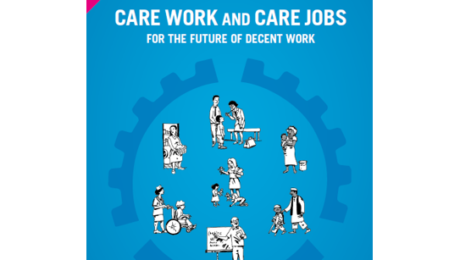Current Policies and Programs Addressing Childcare and Eldercare in South Korea
South Korea has experienced rapid economic growth and accelerated industrialization and modernization within a relatively short period of time in the seventies and eighties (Jang, 2009). Social policies were heavily oriented in supporting the government’s development strategies in terms of increasing human capital and improving health through public investment in these sectors (Song, 2014). Through most of that period, families were encouraged to carry the entire burden of care work and childrearing responsibilities, and social policies played a minimal role in sharing this burden, being mainly targeted to very limited low-income groups. Furthermore, filial piety, called hyo, one of the Confucian ideologies that served as a dominant foundation of state philosophy before the modern era of South Korea, remained even after the establishment of modern government and functioned as an essential foothold in determining care responsibility, unloading it entirely to the family (Lee, 2017).
However, demographic shifts, government regime change, and democratization process highlighted the need to address issues of redistribution and welfare and the important role of the state. The concept of the state serving as the main care provider is now gaining more attention, with its importance highly underlined in the current era of low fertility rates and an aging population in South Korea. In response to increased social awareness and demands, the South Korean government has shown efforts to revalue care work and reach a range of families’ needs.
The major care policies that South Korea currently has in place are:
- the Early Childhood Education and Care Policy,
- the Long-Term Care Insurance (LTCI) Program,
- the Maternity Protection Act, and
- welfare policies for the disabled.
Gilbert and Neil (1974) in their book Dimensions of Social Welfare Policy introduced the idea that social provision can be divided into several types; power, cash, vouchers, time, services, and opportunity. The order of each type represents the degree of freedom of choice; for example, cash represents more freedom of choice compared to services. South Korea’s social and family policies have shown preference for expanding government provided care services, rather than developing social provision in the form of time or cash benefits. However, after recovering from economic crisis (1997-1998) and welfare reform (1999-2001), the Korean government has assumed greater responsibility by legislating, financing, and providing welfare, particularly childcare and elderly care, in public sectors, community level/local government sectors and also supporting the private care market sector. Promoting more care services supported the creation of more jobs in the care sector and allowed unpaid caregivers/housewives to enter labor force as paid careworkers.
South Korea’s social policy has gone through dramatic reforms recently, with the government moving its focus beyond the expansion of existing services towards creating policies (in the form of parental/emergency care leave as well as vouchers and allowances), which provide not only services but also financial support to households who take care of dependent family members on their own.
Currently the basic model for childcare in South Korea is to provide government-supported daycare (9:00 am to 4:00 pm) and education for all children from the ages of 0-6 years. When the model was first introduced, there were several blind spots and families’ needs were not always met. For example, early morning and late-night care (i.e. after 5:00 pm) was not provided. Korean society is notorious for long workhours for employed individuals, and the model doesn’t allow many dual-earner parents to both remain in full-time employment or the model requires them to find additional, often costly, care services. Over the last few years off-hours (7:00 am to 10:00 pm) care services were created and expanded to meet these unmet care needs. In addition, to prevent sole-care burden (“독박육아”, dok-bak-yook-a) among those who raise children alone at home, community-based childcare services for unpaid caregivers (e.g. housewives) were developed by local government subsidies. The prime objective of this service was to create a space for sharing childcare information within the community; engaging in education and entertainment together; and for lessening the burden of care, through services like childcare centers and co-parenting cafés.
Although the government (both central and local) expanded social policy significantly and provided huge amounts of subsidies for these services, several policymakers and researchers point out that parents or caregivers still feel burdened with care for their children and a great proportion of the expenses are still paid by the users.. For most social services, middle-class families are not eligible or only receive partial benefits since these programs mainly target low income families.
Even though the government has expanded social welfare programs since 2000, this was not in effect to impact the fertility rate. Therefore, the service-based childcare model has brought about discussion and debate in South Korea, as people tend to recognize that public services cannot meet the various needs of every family in the country. For example, for child care services, there has been debate on whether or not it is good for young children to stay 7-10 hours in a daycare center. Some scholars have also argued that there is a need to support caring for children “at home” or providing services in a “home-like” environment (Lee and Kim. 2011).
South Korea is also facing a “parental rights movement”, with advocates promoting family time and quality time for caring for children. Providing “time” for parents is the solution they feel will help parents the most. To provide higher flexibility for dual-earner parents who at the same time want to take care of their children by themselves, the government has pushed for a full year paid parental leave program. This was designed to give additional leave to parents who get 90 days maternity leave (fully paid) if they give birth. Both employed mothers and fathers can use full year parental leave until one child gets to age 9, respectively. This leave program guarantees about 50% of personal monthly income (although there is a ceiling for the income compensation). Although this full year parental leave program started in early 2000, it had been rarely practiced, as employers and sometimes even employees were reluctant to use it. However, to boost the low fertility rate, the government is now pushing for parents with young children to actually use this program. This is done by subsidizing (relieving company tax, spending direct financial funds), both in public sectors and private companies. According to labor statistics (2017) only 34,898 mothers and 502 fathers used parental leave in the year 2009, while, in 2017, the number of parents using the leave almost doubled for mothers (78,080) and increased dramatically for fathers (12,043).
In addition to parental leave policies, a financial benefit (age 0-5 years) starting from July 2018 will be provided to families with young children, with the eligibility set by their income level.
Compared to childcare, eldercare provision in South Korea has a shorter history. In 2008, the issue of eldercare gained greater attention, due in large part to the rapid growth of the elderly population and increase in life expectancies. A state-supported model of eldercare was developed as a result. The primary eldercare provision comes from long-term care insurance (LTCI), which allows all elderly with care needs access to non-live-in domiciliary (e.g. home helper services) and community and institutional-based care services, delivered by public and/or private for- and not-for-profit service providers. Unfortunately, the LTCI covered only 7.5 percent of total elderly population (age 65+) in South Korea, according to 2016 statistics (retrieved; http://www.longtermcare.or.kr/npb), while in Japan the eligibility rate is 18.4% and 15.2% in Germany. Despite the low percentage of elderly reached, 2017 statistics show that available eldercare services (both in-home service and institutional- based service) are being used by eligible beneficiaries, 84% and 64% capacity rate. Those who are not eligible for the LTCI are able to access comparable elderly care services within the community-based elderly care providers, which are partly supported by public voucher service, but mostly the cost is paid by individual families (Oh 2014: 1166).
Unlike childcare provision, where not only services but also time and money are given to families with young children, the South Korean eldercare model focuses more narrowly on direct service provision. The LTCI sometimes financed a family member who cares for dependent elderly parents if the adult child acquires a certificate of qualification for in-home eldercare, which is very rare. This feature was introduced to support elderly care in rural areas where in-home care workers or facilities are scarce. Meanwhile, it was expanded, later on, to urban areas (Yoon, 2014) to encourage some unpaid family caregivers to obtain care certificates that enable them to take care of their own parents in a more professional settings and earn a small income. Recently, however, the government announced that they will cut down on such family allowances, which could cause a devastating situation for those family caregivers. In order to compensate their income loss, it will be necessary to get a second job as a care provider and care for other non-family members or seek part-time jobs.
In regard to out-of-pocket expenses, even those families who are eligible for the LTCI benefit are required to pay a copayment. Currently, LTCI covers about 80% for institutional care and 85% for in-home-based care (copayment 20% and 15% respectively). Adult children’s income, commonly from paid full time and part-time work, is needed for caring for their elderly parents, which might drain their time available to care for their parents. Moreover, last year in 2017, the Korean government raised the LTCI payment rate (insurance fee) as well as the copayment rate due to the wage increase for paid caregivers in the LTCI sector, which will likely reinforce the issues described above. Yet, the government announced that they will support low to middle income families by subsidizing the out-of-pocket cost.
In terms of providing leave for caring for dependent elderly, this is much more limited than cash allowance policies. Employed individuals could apply for leave (full 90 days) for a limited period to take care of their parents. However, family leave for eldercare is mostly unpaid, which is very different from parental leave that provides partial income. The low fertility rates among young couples in Korea encouraged policymakers to adopt family-friendly parental leave policies. Unfortunately, although demographic shifts in Korea are a concern (the country is the world’s fastest-aging developed economy), policymakers have not felt the same incentives and pressure to create comprehensive leave policies to enable families to take care of dependent elderly on their own.
As the preceding discussion demonstrates, developing care models in South Korea has been a continuous process, with the government creating policies in quick response to urgent issues and challenges of the time. Despite the expansion in social care provisioning there remains questions of their impact on care recipients and their families. We have little information on how families navigate through the public and private care provision and make decisions about caring for dependent children and elderly family members. The issue of how families choose among different care delivery arrangements and to what extent they are able to combine public provision with their own private resources (i.e. time and money) to meet care needs has not been addressed. To date, little is known on how paid caregivers and unpaid family members develop relationships and emotional bonds with care recipients (i.e. child or elderly), and the linkages between paid and unpaid care work.
We argue that, without a comprehensive framework and a strong view on care, welfare and development, care policies in South Korea have yet to achieve the requisite level of recognition and effective utilization. There is still room for improvement to better meet the needs of families and redistribute responsibilities of care between private households and the public.
This blog was authored by Seung-Eun Cha, Hyuna Moon & Eunhye Kang
References
Kang, Young Wook (2002). Historic Review on the Changes of Infant Rearing Policies. Korean Public Administration History Review 11: 293-332.
Choi, In-Duck. (2014). A Study on the co-payment and the effect of long-term care insurance utilization by income level and region type. Journal of Community Welfare. 48: 135-164.
Hwangbo, Young Ran. (2014). A Historical review of the infant and child care act: Based on the characteristic of the law and the law system. Journal for Early Childhood Education and Care 9(2): 125-146.
Jang, Kyung-sup (2009). Family, Life course, Politics and Economy: Compressed Modernity Seoul: Changbi.
Kim Eun-jeong and Lee Hye-suk. (2016.) Evaluation of the Impact of Child Care Subsidy Program. Korean Institute for Health and Social Affairs.
Lee Meejin. (2017). Change on the family structure and policy for elderly care. Social Welfare & Social Work, 219:20-28.
Lee Seungmie and Kim Seonmi. (2011). A Basic Study on Public Nanny Service Characteristics and Improvement Strategies. Family and Environment Research 49(4): 51-65
Na, J. and Moon, M. (2003). Integrating Policies and Systems for Early Childhood Education and Care: The Case of the Republic of Korea. Early Childhood and Family Policy Series.
Oh, Young-ran. (2014). “A Study to establish social safety net of Elderly LTCI : Implication from the community inclusive care in Japan. Critical Social Welfare Academy Conference Presentation Paper. October 2014. 1166-1185.
Peng, Ito. (2009). Paid Care Workers in the Republic of Korea. UNRISD Research report 4, New York, UNRISD.
Peng, Ito. (2011). The good, the bad and the confusing: The political economy of social care expansion in South Korea. Development and Change, 42(4), 905-923.
Song, Da-young. (2014). Socializing of Caring and Delay of the Welfare State in Korea, Journal of Korean Women’s Studies 30(4):119-152.
- Published in Policy, South Korea, Understanding and Measuring Care
CWE Research Team Presents Prototype Model of the Care Economy at Conference in Colombia
June 13-15, I attended the 21st Annual Conference on Global Economic Analysis, held in Cartagena, Colombia, to present and discuss a draft of an early project output, titled “Care in an Aging East Asian Economy: Simulating the impacts of policies on gender roles, labor markets, and household welfare” and coauthored with two CWE Researcher colleagues, Marzia Fontana and Kijong Kim. The purpose of this paper was to take the first steps toward the development and testing of a computable general equilibrium (CGE) model of South Korea that can analyze policies related to care of both young and elderly. The conference was organized by GTAP, the leading global organization for this area of economic analysis, headquartered at Purdue University. While our paper could draw on the emerging literature of gendered CGE models, this may be the first time such a model is used to analyze issues related to care. In the Korean context, this extension is of outmost importance (like the rest of the project) given the challenges posed by a rapidly growing elderly population, a declining population in working age, and low participation of women in market work, which in its turn partly is due to the fact that women provide most of the care needed by other family members. The forthcoming analysis with the model will focus on policies that improve access to affordable, out-of-home, high quality care from private and public service providers. Empirical model simulations will assess the impact of such policies on a wide range of indicators, including gendered time use and the ability of South Korea’s many highly educated women to earn higher incomes from working more outside the home.
This blog was authored by Hans Lofgren
- Published in Conferences
Research Teams Awarded Funding to Produce Theoretical Gender-Aware Macromodels
The Care Work and Economy project has awarded five research teams funding to produce theoretical gender-aware macromodels that incorporate care in the development context. Each team contributes to one of two broad macroeconomic themes in terms that also account for care work and gender inequality: 1) growth and employment, and 2) social reproduction and structural change.
Care Work and the Economy is excited to advance our understanding of and ability to effectively model the links between care and standard economic variables and concerns by supporting the following teams and their research:
“Social Reproduction, Gender Inequality and Economic Growth” by Elissa Braunstein (Colorado State University) and Stephanie Seguino (University of Vermont)
Braunstein and Seguino develop an empirically tractable macroeconomic model of social reproduction and economic growth, with applications to the challenges of economic development. Their paper sheds light on the following questions: does care matter for long-term growth, how do its effects compare to standard growth regressors like investment and education, and does the extent of gender inequality in responsibility for care partly determine the magnitude of these relationships?
Elissa Braunstein is Professor in the Department of Economics at Colorado State University. In 2015-2017 Braunstein served as Senior Economist at the Division of Globalization and Development Strategies and Officer-in-Charge of the Economic Cooperation and Integration Among Developing Countries unit at the United Nations Conference on Trade and Development (UNCTAD). She has a Ph.D. in Economics from the University of Massachusetts Amherst, and a Master’s Degree in Pacific International Affairs from the University of California San Diego.
Stephanie Seguino is Professor in the Department of Economics at the University of Vermont. She has been an advisor or consultant to numerous international organizations including the World Bank, United Nations Development Program, the Asian Development Bank, and USAID, and publishes regularly in a number of economic journals, including World Development, Journal of Development Studies, and Feminist Economics. Dr. Seguino has also contributed her services to local and global living wage campaigns.
“Long-run Macroeconomics When People are not Exogenous: an overlapping generations approach to fertility, unpaid work, and economic growth” by James Heintz and Nancy Folbre (Political Economy Research Institute at the University of Massachusetts Amherst)
Heintz and Folbre produce an overlapping generations macro model in which production and investment are redefined to include the contribution of unpaid labor. The paper critically examines the standard macroeconomic definitions of income, production, investment, and savings and propose alternatives that take into account unpaid, non-market labor. It then develops a more realistic set of micro-foundations for macroeconomic modeling that incorporates bargaining power, the distribution of income/wealth, gender dynamics, and the costs of children; explore how transfer payments between men and women, between government and households, and between generations affect fertility choice, investments in children, and macroeconomic outcomes.
James Heintz is Associate Director of the Political Economy Research Institute (PERI) and Andrew Glyn Professor of Economics at the University of Massachusetts Amherst. Heintz holds a Ph.D. from the University of Massachusetts and a Master’s Degree from the University of Minnesota. He has written on a wide range of economic policy issues, including job creation, global labor standards, the distributive consequences of macroeconomic policies, and human rights. He has worked on collaborative projects with numerous United Nations agencies, including the International Labour Organization, the U.N. Research Institute for Social Development, the Economic Commission for Africa, the United Nations Development Programme, and UNIFEM.
Nancy Folbre is Director of the Program on Gender and Care Work at PERI and Professor Emerita of Economics at the University of Massachusetts Amherst. In 1998, she received the MacArthur Foundation genius grant award. Her research explores the interface between political economy and feminist theory, with a particular emphasis on the value of unpaid care work. In addition to numerous articles published in academic journals, she is the editor of For Love and Money: Care Work in the U.S. (Russell Sage, 2012), and the author of Greed, Lust, and Gender: A History of Economic Ideas (Oxford, 2009), Valuing Children: Rethinking the Economics of the Family (Harvard, 2008), and The Invisible Heart: Economics and Family Values (New Press, 2001).
“Financialization and the Care Economy” by Srinivas Raghav (NUI Galway) and Ramaa Vasudevan (Colorado State University)
Raghav and Vasudevan develop a macroeconomic model within the structuralist tradition to explore the linkages between financialization, household debt and unpaid care work. The team evaluates the implications of the growth of micro-credit and household debt under financialization for the care economy, as well as their repercussions for the wider macroeconomy.
Ramaa Vasudevan is Associate Professor in the Economics department at Colorado State University. Her Ph.D. in economics from New School University, New York, focused on the political economy of international trade and finance, while her M.Phil at the Centre for Development Studies, Trivandrum, India, was a study about the evolution of labor markets in colonial India. Her main research interests are in international finance, open economy macroeconomics and the political economy of development and finance.
Srinivasan Raghavendran is Lecturer in the Business and Economics department at NUI Galway. His research is focused on a number of major themes in the areas of Macroeconomics, Finance and Complex Systems, and Political Economy. The broad theme that connects various strands of his research is the issue of the dynamic interrelation between economic growth and distribution of income, and his current work focuses on this question in the context of financialisation. Dr. Raghavendra’s research is interdisciplinary. His research draws inspiration from the intellectual traditions of Michal Kalecki and John Maynard Keynes on the substantive front, and uses the methods and tools of Complex systems, to study the dynamics of growth and income distribution in the modern financial economies. Dr. Raghavendra’s research is underpinned by the principle that economic systems cannot be viewed independently of the wider socio-political context.
“Gendering Macroeconomic Analysis and Development Policy: The role of labour market and fiscal policies for gender equitable development” by Ozlem Onaran, Cem Oyvat and Eurydice Fotopoulou (University of Greenwich)
Onaran, Oyvat, and Fotopoulou develop a post-Keynesian, post-Kaleckian, feminist demand-led growth model to analyze the role of both labor market and fiscal policies in achieving gender equitable sustainable development.
Dr. Onaran is Professor of Economics at the University of Greenwich, UK and the director of the Greenwich Political Economy Research Centre. She has done extensive research on issues of inequality, wage-led growth, employment, globalization, gender, and crises. She has directed research projects for the International Labour Organisation, the Institute for New Economic Thinking, the Foundation of European Progressive Studies, the Vienna Chamber of Labour, the Austrian Science Foundation, and Unions21. She is member of the Policy Advisory Group of the Women’s Budget Group, the Scientific Committee of the Foundation of European Progressive Studies, and Scientific Advisory Board of Hans Boeckler Foundation. She has more than seventy articles in books and peer reviewed journals.
Dr. Cem Oyvat is Lecturer in Economics at the University of Greenwich. He received his Phd in Economics from University of Massachusetts – Amherst in 2014 with dissertation titled “Essays on the Evolution of Inequality”. His research interests include development economics, macroeconomics, international economics, income distribution and political economy.
Dr. Eurydice Fotopoulou is Lecturer in Economics at Goldsmiths, University of London. Eurydice’s research focuses on gender and macroeconomics, and in particular structular models that investigate income and wealth distribution inequality. She also works on the impact of labour market and fiscal policies. Her research is interdisciplinary, drawing from economics, sociology and gender studies. Recent collaborative research projects look into the effects of income, gender and wealth inequality, and economic policies on macroeconomic performance.
“Access to infrastructure, women’s time allocation and growth” by Pierre-Richard Agénor (University of Manchester) and Madina Agénor (Harvard University)
Agénor and Agénor develop a stylized model to explore and analyze access to infrastructure, women’s time allocation, and economic growth in developing countries. Pierre-Richard Agénor is Hallsworth Professor of International Macroeconomics and Development Economics at the University of Manchester. Prior to joining the University of Manchester, Professor Agénor was Lead Economist and Director of the Macroeconomics and Policy Assessment Skills Program at the World Bank.He also served as Senior Economist in the Research Department of the International Monetary Fund. During the academic year 2003-04, he was a Distinguished Visiting Scholar at Yale University.
Dr. Madina Agénor, ScD, MPH is an Assistant Professor of Social and Behavioral Sciences at Harvard T.H. Chan School of Public Health (HSPH). She holds a Doctor of Science (ScD) in Social and Behavioral Sciences from HSPH, a Master of Public Health (MPH) in Sociomedical Sciences from the Columbia University Mailman School of Public Health, and a Bachelor of Arts (AB) in Community Health and Gender Studies from Brown University. As a Postdoctoral Research Fellow in the Harvard Education Program in Cancer Prevention at HSPH and Dana-Farber Cancer Institute, she completed postdoctoral training in social epidemiology, cancer prevention and control, and LGBTQ health.
- Published in Policy
ILO Releases New Report on Care Work and Care Jobs
In June the International Labour Organization released their new report Care Work and Care Jobs for the Future of Decent Work. The report analyses the ways in which unpaid care work is recognized and organized, the extent and quality of care jobs and their impact on the well-being of individuals and society. A key focus of this report is the persistent gender inequalities in households and the labour market, which are inextricably linked with care work. These gender inequalities must be overcome to make care work decent and to ensure a future of decent work for both women and men.
The report contains a wealth of original data drawn from over 90 countries and details transformative policy measures in five main areas: care, macroeconomics, labour, social protection and migration. It also presents projections on the potential for decent care job creation offered by remedying current care work deficits and meeting the related targets of the Sustainable Development Goals.
Care Work and the Economy researcher Kijong Kim contributed a background study, co-authored with Ipek Ilkkaracan (Istanbul Technical University), entitled The Employment Generation Impact of Meeting SDG Targets in Early Childhood Care, Education, Health and Long-Term Care in 45 Countries.
- Published in Policy
The Progression of South Korea’s Childcare Model
South Korea’s childcare model started developing when the Child Welfare Act (the Act) was first introduced in 1962. Prior to that, no solid policy for childcare existed, as the country was in a period of political and social turmoil after the Korean war (1950-1953). Thanks to the Act, several nursery facilities were built during this period with foreign assistance, although with the narrow objective of relieving the poor and supporting numerous orphans who lost their parents during the war (Kang, 2002). The Child Welfare Act of 1962 initiated a structured system-level approach to the childcare sector. The Act was still grounded in the notion that families are solely responsible for childrearing unless the children have special needs, in which case government support and protection is warranted. The 1962 law shows clearly that the South Korean government envisioned childcare as a family responsibility, rather than a social policy, which is in accordance with other countries yet to introduce a social welfare system.
However, from the 1960s, when South Korea went through industrialization, the male breadwinner model, which reflected the predominant household type, underwent significant changes. Former housewives started to enter the labor market and a new apparatus was needed to take care of children who were left at home. As a result, the Act for the Promotion of Early Childhood Education (the Promotion Act) was revised in 1982 to meet this need (Hwangbo, 2014). The Promotion Act, however, was aimed at educating children (targeting children age 6-7 to prepare them for entering the primary school system) rather than nurturing them, and the number of available facilities were not sufficient to meet childcare demand from all dual-earner families. Until the 1990s, informal domestic helpers or housemaids, so called sikmo, along with other extended family members represented the greatest form of care for children with working mothers. In the 1990s when industrialization and urbanization accelerated, family size became compact and family type became predominately nuclearized, causing a paradigm shift in how South Koreans regarded childrearing responsibilities. Childcare began to be seen as a social responsibility, rather than solely an individual family’s responsibility.
Following the trend, the Equal Employment Opportunity Act was promulgated in 1987, which supported the implementation of daycare facilities in the workplace. Subsequently, the new version of the Child Welfare Act was established in 1989 and the Infant and Child Care Act was enacted in 1991, both highlighting a significant turning point in the history of childcare policy in South Korea. While the Acts were targeted to benefit low income families, dual-earner low income families, and families with children with special needs, they were groundbreaking in that they framed childcare as a social responsibility and emphasized the provision of government guided facilities and daycare centers (Hwangbo, 2014; Na, 2003). The number of public childcare centers has increased as well as the early childhood education market, and private facilities for young children (age 3-5) has boomed since then. With the introduction of the Infant and Childcare Act, the South Korean government began to consider childcare provision as a public matter and a social responsibility. Although these laws were limited to small numbers of eligible families, they changed how society and the government viewed and framed childcare provision. After the revision of the Social Welfare Services Act and the Act related to the Framework of the Social Security in 1992, childcare gained increasing attention and status, as a way to bridge education and welfare. The broad welfare of children, rather than a narrower focus on education, became an important part of the government’s policy agenda.
In the beginning of the 21st century, South Korea started to face low fertility rates, with births per woman falling to the record low of 1.08 in 2005. Declining fertility rates strongly influenced South Korean policymakers’ views on childcare, leading to the inclusion of ‘support for family’s childcare’ in the government’s childcare policy (Hwangbo, 2014). The government also developed the Basic Act on Low Fertility and Aging in 2005, expanding eligibility for public childcare provision to any dual-earner couple with preschool children. Since then the public childcare provision has been extended to include families with single-earners as well. To expand beneficiaries of the Act, a new policy on Early Childhood Education and Care (ECEC) was developed, which provided financial support for all infants and children from every income category, not only for parents who use public childcare centers but also for families using private childcare facilities. The provision emphasized universal public financial support of the government to provide childcare (Kim and Lee 2016: 11; Peng 2011). The Childcare Support Act was established in 2012, and the age range of the beneficiaries expanded further to children 36 months old.
This blog post was authored by Seung-Eun Cha, Hyuna Moon and Eunhye Kang.
References
Kang, Young Wook (2002). Historic Review on the Changes of Infant Rearing Policies. Korean Public Administration History Review 11: 293-332.
Choi, In-Duck. (2014). A Study on the co-payment and the effect of long-term care insurance utilization by income level and region type. Journal of Community Welfare. 48: 135-164.
Hwangbo, Young Ran. (2014). A Historical review of the infant and child care act: Based on the characteristic of the law and the law system. Journal for Early Childhood Education and Care 9(2): 125-146.
Jang, Kyung-sup (2009). Family, Life course, Politics and Economy: Compressed Modernity Seoul: Changbi.
Kim Eun-jeong and Lee Hye-suk. (2016.) Evaluation of the Impact of Child Care Subsidy Program. Korean Institute for Health and Social Affairs.
Lee Meejin. (2017). Change on the family structure and policy for elderly care. Social Welfare & Social Work, 219:20-28.
Lee Seungmie and Kim Seonmi. (2011). A Basic Study on Public Nanny Service Characteristics and Improvement Strategies. Family and Environment Research 49(4): 51-65
Na, J. and Moon, M. (2003). Integrating Policies and Systems for Early Childhood Education and Care: The Case of the Republic of Korea. Early Childhood and Family Policy Series.
Oh, Young-ran. (2014). “A Study to establish social safety net of Elderly LTCI : Implication from the community inclusive care in Japan. Critical Social Welfare Academy Conference Presentation Paper. October 2014. 1166-1185.
Peng, Ito. (2009). Paid Care Workers in the Republic of Korea. UNRISD Research report 4, New York, UNRISD.
Peng, Ito. (2011). The good, the bad and the confusing: The political economy of social care expansion in South Korea. Development and Change, 42(4), 905-923.
Song, Da-young. (2014). Socializing of Caring and Delay of the Welfare State in Korea, Journal of Korean Women’s Studies 30(4):119-152.
Yoon, J. (2014). Counting care work in social policy: Valuing unpaid child-and eldercare in Korea. Feminist Economics, 20(2), 65-89.
- Published in Policy
Why Do we Need to Rethink Macroeconomics?
Since the 1980s, growth processes have been undermined by inadequate understanding of the interconnection between standard notions of “the economy” and the care economy. The consequences of gender-blind economic policies, and the sorts of growth and distribution dynamics that result, particularly for gender inequalities and care provisioning, have been far reaching and complex. They require a deeper understanding of the ways that the invisibility of unpaid care in macroeconomic policy formulation and analysis have led to persistent underinvestment in care provisioning, reproducing and reconfiguring gender hierarchies.
This is particularly important in the context of the rapidly increasing differentiation across households across the globe in terms of ability to access paid care services for childcare and elderly care, the stalling of women’s participation in the labor market, and the consequent shift in global demographics (aging in some regions, population growth in others). There is almost no work to date on the gendered impact of fiscal and monetary policies that moderate the shift of the provision of care services from households onto the public and private market sectors. Such changes will affect macroeconomic outcomes through their impact on the distribution of women’s time between paid and unpaid labor, the productivity of care work, and the associated impacts on labor force participation rates, savings, pension accumulation, and tax contributions. There are distributional consequences as well, as these processes have differentiated effects by class, race or ethnicity, age and migration status. The current over-reliance on gender-blind representative agent models renders these dynamics invisible.
The following papers offer great introductions to the importance of engendering macroeconomic theory and policy:
Why macroeconomic policy matters for gender equality by James Heintz (UN Women 2015):
This brief synthesizes research findings, analysis and policy recommendations on creating an alternative gender-responsive macroeconomic agenda.
Macroeconomic policy, including fiscal and monetary policy, is often thought of as gender-neutral. But economic policy choices affect women and men differently because of their different positions in the economy, both market (paid) and non-market (unpaid). For instance, budget cuts that reduce social spending may increase the demands on women’s unpaid household labour, while trade liberalization may negatively affect women’s employment in contexts where they are overrepresented in import-competing sectors, such as agricultural food crops. Yet, macroeconomic policies to date have paid scant attention to these issues and have therefore not been conducive to the achievement of gender equality.
Focusing on goals, measurement and policy instruments, this brief lays out the key problems with current macroeconomic policies and provides building blocks for an alternative macroeconomic agenda that is rights-based and gender-responsive.
Engendering Macroeconomic Theory and Policy by Stephanie Seguino (World Bank 2017):
This survey paper reviews the main threads of the subfield of gender and macroeconomic literature. It looks first at research linking gender relations embedded in institutions at every level of the economy, from the household, labor, and credit markets to economic development and growth. It then reviews the reverse causality: the differential impact of macro-level policies on men and women. Following these assessments, the paper proceeds to identify topics for future research, focusing on areas where adding a gender dimension would sharpen macro-economic models and increase the relevance of their results. Given the large body of research available, this review is not exhaustive, but instead, focuses on research publications that have significantly influenced the way we understand the two-way causality between gender and the macroeconomy.
- Published in Rethinking Macroeconomics






